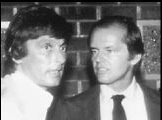Genuinely wanting to meet the guy, I was disappointed to learn that 72-year-old Robert Evans couldn’t continue his press tour up to Seattle (on doctor’s orders). Sure, we could speak by phone, but that’s no way to honor an icon of the late ’60s and early ’70s—the very time I hoped to ask him about. I’d previously sat through The Kid Stays in the Picture while taking notes on the period details of an era that, according to conventional film-geek wisdom, spawned a brief, great chapter in American cinema.
Is that really true? Evans is certainly in a position to know. Looking beyond his production credits, however, let’s applaud the wide-open-necked shirts, double-breasted suits, bolo ties, bell-bottoms, and three-button cuffs the man brought to Hollywood fashion. His story of rag- trade-to-riches is one of looking the part of a hip young movie mogul. At a time when the doddering, sclerotic Paramount studio was hopelessly out of touch with baby boomers, Evans’ image screamed youth culture.
Recalling establishment-rocking pictures like Harold and Maude and Medium Cool in a recent Variety interview, Evans declares, “We were rebels. Usually everyone in Hollywood is overpaid, so they’re worried about losing their jobs. We were underpaid, so we weren’t worried.”
In other words, during his years at Paramount (1966-74) and subsequent stint as an independent producer (which ebbed after ’84), the stakes were lower. Movies were cheaper to make—and especially to market—until Jaws, Star Wars, and the Indiana Jones series changed Hollywood math with all those extra zeros.
The short-lived freedom of the Evans era is communicated in his voluminous photo archive in Kid, which animates glossy old stills with decidedly un-Burnsian CGI. The photos are mostly in color, yet somehow they have the poignancy of sepia.
Final note: Sit through Kid‘s credits—there’s a hilarious, ribald cameo at the end.









